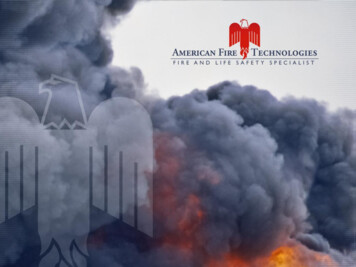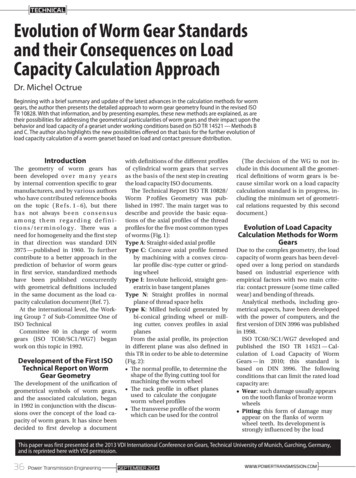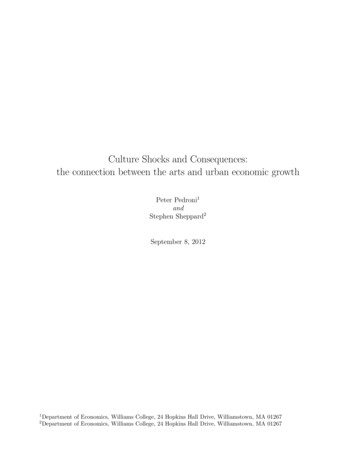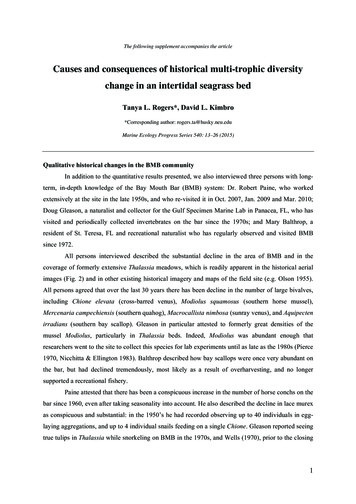
Transcription
Unintended Consequences
NFPA 855- Energy Storage SystemsESSOUR GOALS Unintended Consequences – NFPA 855 ESS Where is it heading?What does it mean for UtilitiesFuture Code RequirementsTypes of products to meet codeDesign RequirementsStandard SizesRecommendations
Risk Based A System design is based on reasonablyanticipated events to control the fire until aninformed party can determine the nextcourse of action.
ESS - Electrical Hazard Risk Based hazard What is your/client tolerance for risk.Electrical – Deep Seated FireDetection vs suppressionAsset protectionTurning it off does not eliminate thehazard Life Safety- First responders
Code Cycle1st draft was out for public comment in10/17. 550 public inputs Two draft reviews meetings - 10/17 and 11/171st draft out April 11th 2018Public comment closed June 20th 2018. 880 Public comments submittedSecond Draft planned Jan 3rd 2019
Code Cycle Target for NFPA publication - 2019 Possibility of NITMAN will push it out until 2020for code issue? Committed Make Up - Manufacures, codeenforcement, special knowledgeLimited in installers/utility based
Code Basis Familiar with NFPA 850? Is a recommendpractice or a should code. Most of yourproperty operated under this code. 855 Will be a requirement or a shall code.May run into conflicts on Utility based property.
Code BasisKey Issues Use of UL 9540 will be a listing issue and referenced heavily in the code. Defined facility code requirements will be by location – Tables Dedicated use vs remote location Outdoor vs indoor Life Safety vs unoccupied Any thing outside of the defined levels will be allowed by “large Scale FireTesting”Covers all energy storage not just Lithium Ion Batteries
Code Basis Chapter 1 – Overall requirements. 1.2 Purpose. This standard provides the minimum requirements forthe fire prevention, fire protection, design, construction, installation,commissioning, operation, maintenance, and decommissioning ofstationary, mobile, and portable ESS. 1.3* Application. This standard applies to the following:(1) Stationary ESS having capacities exceeding the values shown in Table 1.3(2) Mobile ESS used in stationary applications(3) Portable ESS interconnected to provide a stationary source of power Submitted - 1.3.1 This standard shall not apply to ESS which are anintegral part of a generating plant or substation.(failed)
Code TablesTABLE 1.3 Stationary ESS Threshold QuantitiesaFor ESS units rated in amp-hrs, kWh equals rated voltage times amp-hr rating divided by1000.Aggregate CapacityaESS TechnologykWhBattery ESSLead acid, all typesNickel-cadmium (Ni-Cd)Lithium-ion, all typesSodium, all typesFlow batteriesbOther battery technologiesBatteries inresidentialoccupanciesCapacitor ESSCapacitors, all typesOther ESSAll other ESSMJ70702020c201012522527272c72363.6310.870252
Code BasisChapter 4 will be the driving force behind theyour requirements –4.4.1 ESS installed indoors, outdoors, on rooftops andin open parking garages shall comply with this section.1st draft copy/draft first revision copy available. First revision not out yet.
4.4.2 Indoor installations. 4.4.2.1 Indoor ESS installations shall comply with this section.4.4.2.2 Dedicated use buildings. For the purpose of Table 4.4.2dedicated use ESS buildings shall be constructed in accordance with localbuilding codes and comply with all the following.:The building shall only be used for electrochemical energy storage, energygeneration, and other electrical grid related operations.Occupants in the rooms and areas containing ESS are limited to personnelthat operate, maintain, service, test and repair the ESS and other energysystems.No other occupancy types shall be permitted in the building, and.Administrative and support personnel shall be permitted in incidental useareas within the buildings that do not contain ESS, provided:
Indoor Cont The areas do not occupy more than 10 percent of the building area of thestory in which they are located.The areas are separated from the ESS and other energy system roomsand areas by two hour fire barriers and two hour fire-resistance ratedhorizontal assemblies constructed in accordance with the locally enforcedbuilding code, as appropriate.A means of egress is provided from the incidental use areas to the publicway that does not require occupants to traverse through areas containingESS or other energy system equipment. 4.4.2.3 Non-dedicated use buildings. For the purpose of Table 4.4.2 nondedicated use buildings include all buildings that contain ESS and do notcomply with Section 4.4.2.1 dedicated use building requirements.
TABLE 4.4.2INDOOR ENERGY STORAGE SYSTEMS (ESS)COMPLIANCEDEDICATED USE BUILDINGS aNON-DEDICATED USEBUILDINGS bREQUIREDChapters 1-3YesYes4.1 – 4.3 GeneralYesYesYesYesNoYesYesYesNot ApplicableYesYes cYesYesYes4.9 Water supplyYesYes4.11 SignageYesYesNot allowedYesYesYes4.6 Size andseparation4.5 Maximumrated energy4.4.1 Elevation4.4.3.1Separation4.7 Smoke andfire detection4.8 Fire controland suppression4.4.6 Occupiedwork centersChapter 9-17Technologyspecificprotectiona. See Section 4.4.2.2.b. See Section 4.4.2.3.c. When approved, alarm signals arenot required to be transmitted to anapproved location when local fire alarmannunciation is provided and trainedpersonnel are always present.
Recommendations – Submitted –Failed 4.4.1 ESS installed indoors, outdoors, on rooftops and in open parking garages shallcomply with this section. 4.4.1.1 ESS facilities under the exclusive control of the electric utility and meeting allof the conditions shown in 4.4.1.1(1) through 4.4.1.1(4) below shall not be requiredto meet the Provisions of Chapter 4(1) The ESS is installed on electric utility property(2) The ESS is installed in a dedicated use ESS building as defined section 4.4.2.2complying with the remote location requirements of 4.4.3.2 (1) or the ESS is installedoutdoors complying with the remote location requirements of 4.4.3.2(1)(3) There is controlled access to the property provided by fencing, locked facilities, ormanned guard stations(4) There is restricted access to first responders according the emergency responseplan utilized by the electric utility for high voltage facilities
Recommendations – Submitted –Failed 4.4.1 ESS installed indoors, outdoors, on rooftops and in open parking garages shallcomply with this section. A 4.4.1.1 .Electric utilities should refer to NFPA 850 Chapter 4 for the appropriatefire protection design process for a comprehensive evaluation of risks posed byESS. As part of the design process, electric utilities should utilize NFPA 855 section4.4. and subsequent chapters to evaluate risk and determine mitigation factors suchas those shown in NFPA 855 Tables 4.4.2 and 4.4.3. Electric utility locations that would meet the definition of remote would beconsidered asset risks (not risks to the public or first responders) whose protectionshould be determined by the risk profile of the utility. These locations arecharacterized by no public access, limitations on access by first responders, andseparation from spaces accessible to the public.
Recommendations – Submitted – SoFar d. Where dedicated use buildings meet the definition of remote locationsshown in section 4.4.3.2 below and where agreeable with theelectrochemical energy storage system owner and approved by the AHJ,fire suppression systems and water supply are permitted to be omitted
4.4.3 Outdoor installations. 4.4.3.1 Outdoor ESS installations shall comply with this section. 4.4.3.2. For the purpose of Table 4.4.3 outdoor ESS installations shall beclassified as follows:Remote locations - Remote outdoor locations include ESS located morethan 100 feet (30.5 M) from buildings, lot lines, public ways, storedcombustible materials, hazardous materials, high piled stock and otherexposure hazards. ADDED . ESS installations on property shared withother electrical infrastructure that is under the same ownership shall not beconsidered to create an exposure for the purposes of this section .Locations near exposures – Include all outdoor ESS locations that donot comply with remote outdoor location requirements.
TABLE 4.4.3OUTDOOR STATIONARY ENERGY STORAGE SYSTEMS a(ESS)Chapters 1-3YesYes4.1 – 4.3 GeneralYesYes4.4.3.3 Maximum sizeYesYesNA Not applicable.a. See Section 4.4.3.2, item 1.b. See Section 4.4.3.2, item 2.c. In outdoor walk-in units, spacing isnot required between electrochemicalenergy storage units and the walls ofthe enclosure.4.4.3.4 Clearance to exposuresYesYesd. When4.4.3.5 Means of egressNAYes4.4.3.6 Walk in unitsYesYes4.4.3.7 Vegetation controlYesYes4.4.3.8 EnclosuresYesYes4.6 Size and separationNoYes c4.5 Maximum rated energyNoYes4.7 Smoke and fire detectionYesYes4.8 Fire control and suppressionYes dYes4.10 Water supplyYes dYes4.11 SignageYesYes4.4.6 Occupied work centersNot allowedNot allowedYesYesCOMPLIANCE REQUIREDREMOTE LOCATIONS aLOCATIONS NEAREXPOSURES bChapter 9-17 Technology specificprotectionagreeable with theelectrochemical energystorage system owner andapproved by the AHJ, firesuppression systems andwater supply are permittedto be omitted.
4.4.3 Outdoor installations. 4.4.3.3 Maximum size. Outdoor walk-in containers or enclosures housing ESS shallnot exceed 45 ft. by 8 ft. by 9.5 ft. high. Units that exceed these dimensions shall betreated as indoor installations and comply with the requirements in Section 4.4.2.4.4.3.4 Clearance to exposures. ESS located outdoors shall be separated by aminimum ten feet (3048 mm) from the following exposures:1. Lot lines2. Public ways3. Buildings4. Stored combustible materials5. Hazardous materials6. High-piled stock7. Other exposure hazards( added) not associated with generation of power
4.4.3 Outdoor installations. 4.4.3.4.3. Clearances to buildings are permitted to be reduced to 3 ft. (914.4 mm)where the weatherproof enclosure of the ESS is constructed of noncombustiblematerials and it has been demonstrated that a fire within the enclosure will not ignitecombustible materials outside the enclosure based on large scale fire testingcomplying with Section 4.5.
4.6* Size and Separation. 4.6.1 ESS in the following locations installed indoors shall comply with 4.6.2 and4.6.3 unless otherwise permitted by Section 4.6.4 or 4.6.5.1.Indoor ESS installations in accordance with Section 4.4.2.2.Outdoor ESS installations in locations near exposures as described in Section4.4.3.2 (2).3.ESS installations in open parking garages and on rooftops of buildings asdescribed in Section 4.4.4.2 shall not exceed the maximum rated energy values inTable 4.54.In mobile ESS equipment in accordance with Section 4.5.4.6.2 ESS shall be comprised of groups with to a maximum energy level of (50)(300) (1,000) 250 kWh each.
4.6* Size and Separation. 4.6.3 Each group shall be spaced a minimum 3 ft. (914 mm) from other groups andfrom walls in the storage room or area. 4.6.4 The AHJ shall be permitted to approve listed pre-engineered and prepackagedESS groups with larger capacities or smaller groups spacing based on if large-scalefire and fault condition testing conducted complying with Section x.x or witnessedand reported by an approved testing laboratory is provided showing that a fireinvolving one array will not propagate to an adjacent array and be contained withinthe room for a duration equal to the fire resistance rating of the room separationrequired by 4.4.2.1. 4.6.5 Section 4.6.2 and 4.6.3 do not apply to lead-acid and nickel-cadmium batterysystems less than 50-V ac, 60-V dc in telecommunications facilities and incompliance with NFPA 76.
4.5 Maximum Rated Energy ESS in the following locations shall comply with Section 4.5 as follows:Fire areas within non-dedicated use buildings as described in Section 4.4.2.3containing ESS exceeding the maximum rated energy values in Table 4.5 shallcomply with all applicable high hazard requirements as identified in 6.2.2 of NFPA101 and the building code.Outdoor ESS installations in locations near exposures as described in Section4.4.3.2 (2) shall not exceed the maximum rated energy values in Table 4.5ESS installations in open parking garages and on rooftops of buildings as describedin Section 4.4.4.2 shall not exceed the maximum rated energy values in Table 4.5Mobile ESS equipment, as covered by Section 4.5, shall not exceed the maximumrated energy values in Table 4.5
4.5 Maximum Rated EnergyTABLE 4.5 Maximum Rated ESS EnergyESS TypeLead acid batteries, all typesNickel-cadmium batteries (Ni-Cd)Lithium-ion batteries, all typesSodium batteries, all typesFlow batteries†Other battery technologiesCapacitors*ForMaximum Rated Energy*(kWh)60060060060060020020batteries and capacitors rated in amp-hrs, kWh should equal rated voltage times amp-hr rating divided by 1000.vanadium, zinc-bromine, polysulfide bromide, and other flowing electrolyte-type technologies.†Includes
4.5 Maximum Rated Energy 4.5.1 Fire areas in telecommunication buildings complying with NFPA 76 that contain lead-acidand nickel-cadmium battery systems operating at lower than 50-V ac, 60-V dc nominal shall beconsidered ordinary hazard.4.5.2 Where approved by the AHJ, fire areas in non-dedicated use buildings containing ESS thatexceed the amounts in Table 4.5 shall be permitted to be treated as an ordinary hazard and not ahigh hazard classification based on a hazardous mitigation analysis in accordance with Section4.15 and large-scale fire and fault condition testing conducted complying with Section 4.5.4.5.3 Where approved by the AHJ, outdoor ESS installations, ESS installations in open parkinggarages and on rooftops of buildings, and mobile ESS equipment that exceed the amounts inTable 4.5 shall be permitted based on a hazardous mitigation analysis in accordance withSection 4.15 and large-scale fire and fault condition testing complying with Section 4.5.4.5.4 Where fire a
A 4.4.1.1 .Electric utilities should refer to NFPA 850 Chapter 4 for the appropriate fire protection design process for a comprehensive evaluation of risks posed by ESS. As part of the design process, electric utilities should utilize NFPA 855 section 4.4. and subsequent chapters to evaluate risk and determine mitigation factors such as those shown in NFPA 855 Tables 4.4.2 and 4.4.3. Electric .File Size: 1MBPage Count: 49











